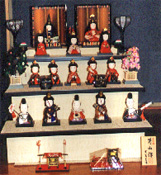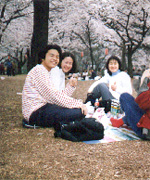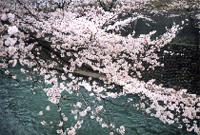Lesson 10
Culture notes Download pdf
Hina Matsuri / Sakura
Hina Matsuri, or Girls’ Day Festival is celebrated annually on March 3rd. Families with daughters will usually display an arrangement of dolls to promote their health and happiness and to ward off evil spirits.The number of dolls displayed varies, although it is common to have a tiered stand (hina-dan) with between 5-7 shelves on which the dolls are exhibited. The stand is covered in red cloth, red being considered a symbol of luck.
The dolls are dressed in Heian style costumes (794AD-1192AD) and the top shelf is always reserved for the Emperor and Empress. They will usually be seated before a gold screen as was traditional during that period. Two lanterns will often also be placed next to Emperor and Empress. On the next shelf will be the ladies in waiting (often carrying trays of banquet food) and on the shelf below, the court musicians. Other auspicious symbols on display may include peach blossom which is associated with the feminine traits of gentility and composure and other items of miniature furniture including an ox cart and a tea service.
The same dolls are used every year and are usually passed down through families. They are brought out about ten days before March 3rd, but are put away as soon as the festival is over. To leave the dolls out is considered bad luck and it is said parents may have trouble marrying off their daughters. The practise of displaying dolls began during the Edo period (1608-1868) and dolls at that time were traditionally made out of paper. After the girls’ day, the dolls would be thrown into the nearest river as a means of carrying away bad luck, illness and misfortune. Some towns and villages throughout Japan still maintain this custom.

A hinadan doll stand
Cherry Blossom (Sakura)
Cherry blossom is often considered to be the symbol of spring in Japan.
When the delicate pink flowers come into bloom, they mark an end to the
harsh conditions of winter and show signs of the new life to come. The cherry
blossoms are also said to represent the transience of human life since they
only bloom for a couple of days before wilting and scattering their petals.
Cherry blossom are also therefore viewed with a tinge of sadness in that
something so beautiful can only last for such a short time. Over the centuries,
many poets have been inspired by these tiny blooms and there are many
poems and haiku reflecting the cherry blossom season.
Sakura viewing is taken very seriously in Japan and the national weather will even give regular forecasts on which part of the country has the most flowers in bloom at any one particular time.
Japanese people will celebrate the flowers by attending ‘flower watching parties’ or ‘hanami’. This generally involves sitting under the cherry blossom trees and enjoying a picnic with friends/ family and colleagues.


A ‘hanami’ party to enjoy the beautiful cherry blossom
Visit the Japan Society Hina Matsuri Page or Hanami Page for further lesson
resources and activity ideas:
https://www.japansociety.org.uk/resource?resource=12 (Hina Matsuri)
https://www.japansociety.org.uk/resource?resource=30 (O Hanami)